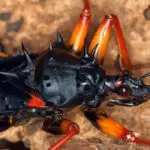If you are looking for an accessible and entry level, large beetle to keep as a pet, the elephant beetle is something that you should consider. In this guide, I will teach you how to care for elephant beetles, Megasoma spp.
To keep Megasoma beetles, place the grubs in ventilated containers filled with moist flake soil. Replaced the consumed flake soil on a regular basis until the grubs turn into pupae. Transfer the emerged adult beetle to another container with a secure lid. Feed the beetle with fresh cut fruit or beetle jelly.
As summarized above, caring for Megasoma beetles is quite straightforward. Continue reading to understand more about their habits, behaviors, and other important aspects of their care.
Introduction to Megasoma Beetles
Megasoma spp, or elephant beetle, is a species of scarab beetle. They are also called the rhinoceros beetles. In most species, the male elephant beetle has a horn on its head, and 2 horns on its thorax, one at each side. Meanwhile, the female beetles do not have horns.
Depending on the nutrition, rearing conditions and some unknown factors, the male Megasoma beetles may have a huge cephalic horn on its head, or a small one. Those with a huge horn are called the major male, while those with a shorter horn are called the minor.
As implied by their name “mega” which means big, and “soma” which means body, elephant beetles are big. Larvae of certain species can easily exceed 150 g in weight. Meanwhile, the adult beetles measure between 50-130 mm (~2-5 inch) in length, including the horn.
Having said that, there are also small Megasoma species. That includes Megasoma punctulatus native to the US, measuring between 25-65 mm (~1-2.5 inch).
Some of the famous and large Megasoma beetles include Megasoma elaphas, Megasoma actaeon and Megasoma mars.
The biggest captive adult Megasoma beetle recorded in BE-KUWA (consider it a beetle-specific world record) is as below:
- Megasoma actaeon – 133.2 mm
- Megasoma mars -132.7 mm
- Megasoma elaphas – 130.9 mm
Elephant beetles are nocturnal species active at night. The adult beetles feed mainly on tree sap and fruits, while larvae feed on decaying wood.
Overall, Megasoma are beginner-friendly pet beetles. They are hardier than some other rhinoceros beetles in terms of temperature tolerance, and the grubs are not overly picky on their food.
Depending on species and rearing conditions, it takes about 1-4 years for Megasoma beetles to reach adulthood from egg. Bigger species have a longer development time than the smaller species. The adult beetles can live for 6-8 months.
Recommended Resources and Supplies
Here are my recommended supplies and resources that you can consider getting for your Megasoma beetles. I’ll earn a small commission from eligible purchases you make after clicking those links. It helps me maintain this site without additional cost to you.
The Ultimate Guide to Breeding Beetles: Coleoptera Laboratory Culture Methods
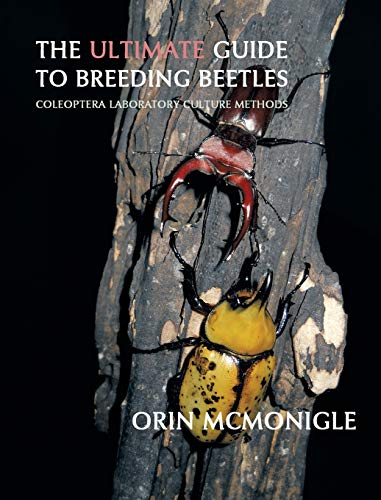
I call this book the encyclopedia of beetle keeping. It contains comprehensive information on rearing all sorts of beetles, including the rhinoceros beetles (eg. Megasoma spp), stag beetles, flower beetles, dung beetles, and so on. Whether you are a beginner or expert in beetle keeping, this book definitely blows your mind. While it is not cheap, it is definitely worth the money!
Other Supplies
- Housing for adult beetle
- Substrates for adult beetles
- Beetle Jelly
- Nursery housing
- Housing for grubs
- Heat mat
- Thermometer & Hygrometer
Buying Megasoma Beetles
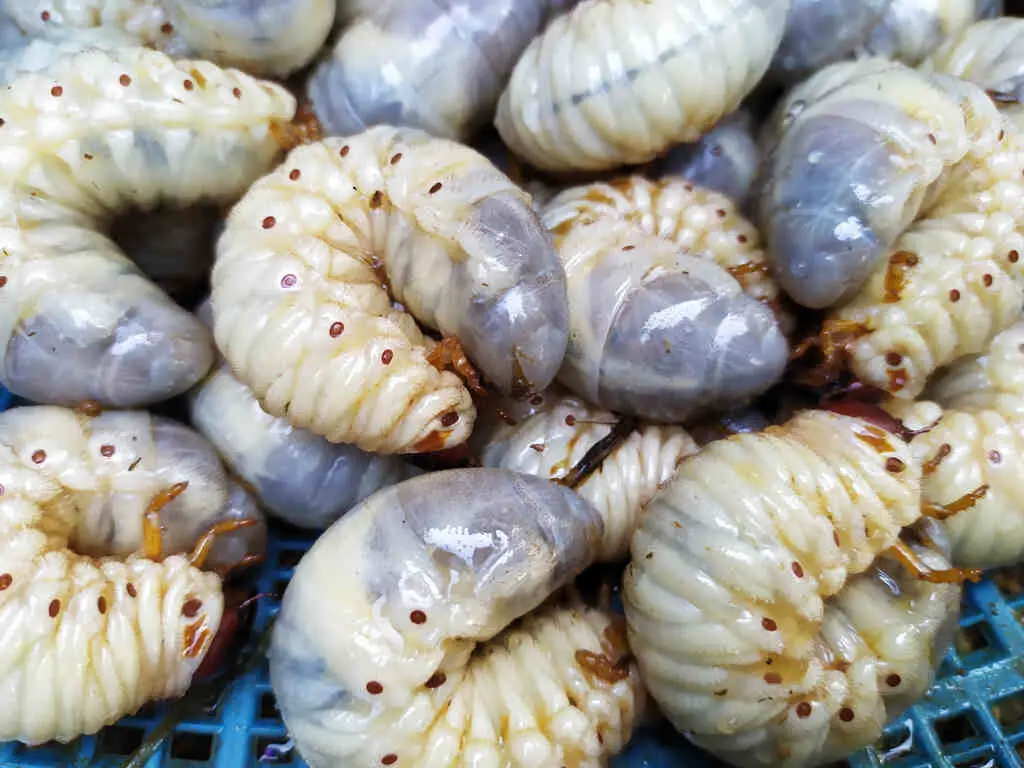
Most of the time, you can only buy Megasoma beetles online from breeders. Local pet stores do not typically sell them (unless you are in Japan, where beetle-keeping is a norm).
Depending on your location, certain species are easier to obtain than others. Some are more expensive than others due to rarity and difficulties to breed. Don’t be too obsessed about the species to keep if this is your first beetle.
Always buy the grubs or larvae, instead of adult beetles. Adult Megasoma live for only a few months, and there is no way to ascertain their age. You do not want to buy a beetle that is too old.
But of course, you can always buy an adult Megasoma beetle if lifespan is not an issue for you. Note that it will be much more expensive, though, since a lot of time and resources have been invested by the breeders to grow the beetles into adults.
There are 4 larval instars in Megasoma beetles. The 3rd and 4th instars are hardier than the 1st and 2nd instars. Try buying a couple of them, because not all grubs will turn into adult beetles.
Housing and Caring for Grubs
Beetle grub caring is straightforward and boring. The grub spends its entire life in the flake soil, and you can hardly see it. Even so, they are dedicated and vulnerable if you do not know how to take care of them. So, make sure you read and understand this section fully.
Enclosure
Your grubs do not need a fancy enclosure. Any plastic container with a wide opening and a lid can be used. A container with a big opening allows you to easily work on your grub. Also, try using a transparent container, so that it is easier for you to locate the cryptic grub, if required. Remember to poke some holes on the container wall for ventilation.
As a general rule of thumb, the bigger you want your beetle to grow, the larger the container is required.
You can use a 250 mL container for the first and second instars, since they are small in size. However, third and fourth instars require bigger containers. For bigger species such as Megasoma elaphas, M. mars and M. actaeon, I would use a 4 L container for third and 10 L for fourth instars.
First and second instar grubs can be housed in the same container, as long as you use a big one. However, older grubs are typically housed separately so that they do not hurt each other, especially when molting.
Flake Soil Preparation
Megasoma grubs live in and feed on decaying wood. To grow the grubs, you need flake soil. I have a flake soil recipe that you can refer to.
Put the flake soil in a big bucket, and add some water. Mix the flake soil evenly with water until it is moist but not overly wet.
To check if the moisture is right, take a chunk of moist flake soil, and hold it firmly in your fist. If there is no water dripping when you hold the flake soil, and the flake soil holds its shape momentarily when released, you have nailed it.
Add more flake soil if the mixture is too wet, and add more water if it is too dry.
Housing the Grubs
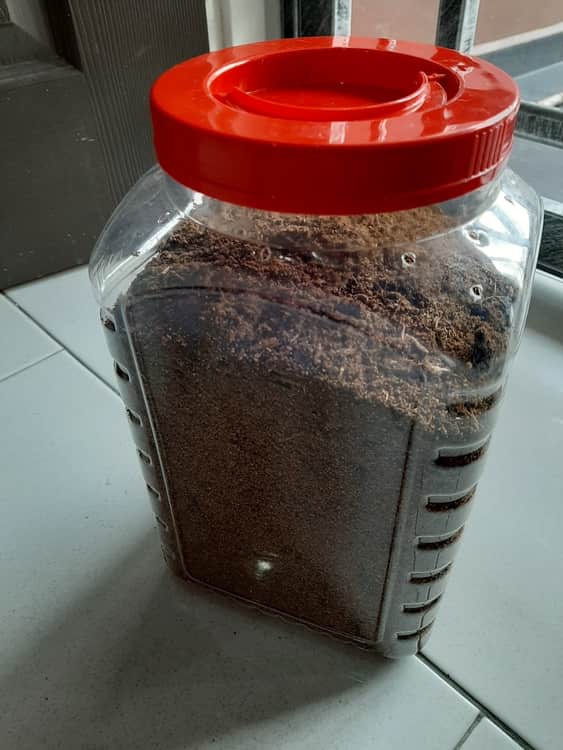
Add moist flake soil to the container, and press lightly to compress the flake soil until it is almost full. Place the grub onto the flake soil, and let it burrow. Cover the container with its lid.
Keep the grub somewhere dark and cool, ideally between 20-25 °C (68-77 °F). Temperature control is a must if you want to get a huge beetle. Avoid disturbing the grubs.
Replenish Flake Soil
Grubs consume the flake soil and pass out frass. Hence, you need to replace the consumed flake soil from time to time.
Once every 2 months, dig out some flake soil from the container. If more than half of the flake soil has been consumed, it’s time to change the flake soil.
Carefully remove the flake soil from the container so that you do not hurt the grub. If you see the grub not moving, it is probably molting. The molting grub is extremely vulnerable. So, do not touch or disturb it. Put back all the flake soil, and wait for 1-2 weeks before trying to change the flake soil again.
If you are going to use the same container, I recommend washing it with tap water and mild soap. You will need a brush, because some flake soil or frass will stick on the container wall.
If you hit something hard when removing the flake soil, and it is about time for your grub to pupate, it could be the pupation chamber. Refer to the pupation section for more details.
Prepare new flake soil and fill up the container according to the steps outlined earlier. Add some old flake soil into the new one so that whatever beneficial microbes are transferred to the new flake soil. Obviously, you should not do this if your old flake soil is infested by mold or mites.
Put the grub on the new flake soil and cover the container.
Dealing with Dried Flake Soil
Sometimes, the flake soil dries up before it is time to change. This could be due to a hotter environment, too much ventilation, or inactive/sick grub.
If this happens, you can either add some water to the flake soil, or replace it with fresh flake soil. I prefer the latter because it is not easy to gauge the moisture and do water mixing with the grub inside. If I am going through the hassle, I might as well just replace all the flake soil.
Molting Care
Megasoma grubs undergo 4 molts before they become pupa. When molting, their newly-formed exoskeleton is too soft to protect them. More often than not, you will not see them molting. But if you do, leave them alone, and do not touch them to avoid hurting them.
Pupation
Depending on species and temperature, the time required from hatching to pupation varies. Generally, larger species have a longer life cycle, and a warmer environment promotes a faster growth rate (but smaller sized beetles).
For instance, Megasoma actaeon and M. janus take 2.5-3 years to pupate, while the smaller M. punctulatus require only 8-12 months.
If you want a larger species with a shorter development time, Megasoma elaphas is a good option, where it takes only 18-21 months to turn pupa.
Before pupating, the grub will turn yellowish. This is a stage known as the pre-pupa, which lasts for 2-3 months. When you see a pre-pupa while changing the flake soil, this will be the last time you do a flake soil replenishment.
The pre-pupa will eventually encase itself within a pupation chamber. Inside the chamber, it turns into a pupa, before finally emerging as an adult beetle.
For beginners, I advise against breaking the pupation chamber. Some experienced hobbyists prefer to put their pupae in an artificial chamber, while some excavate the pupation chamber for better monitoring. However, this is risky for the inexperienced.
You should only resort to an artificial chamber only if you accidentally break the pupation chamber.
Emergence as Adult Beetle
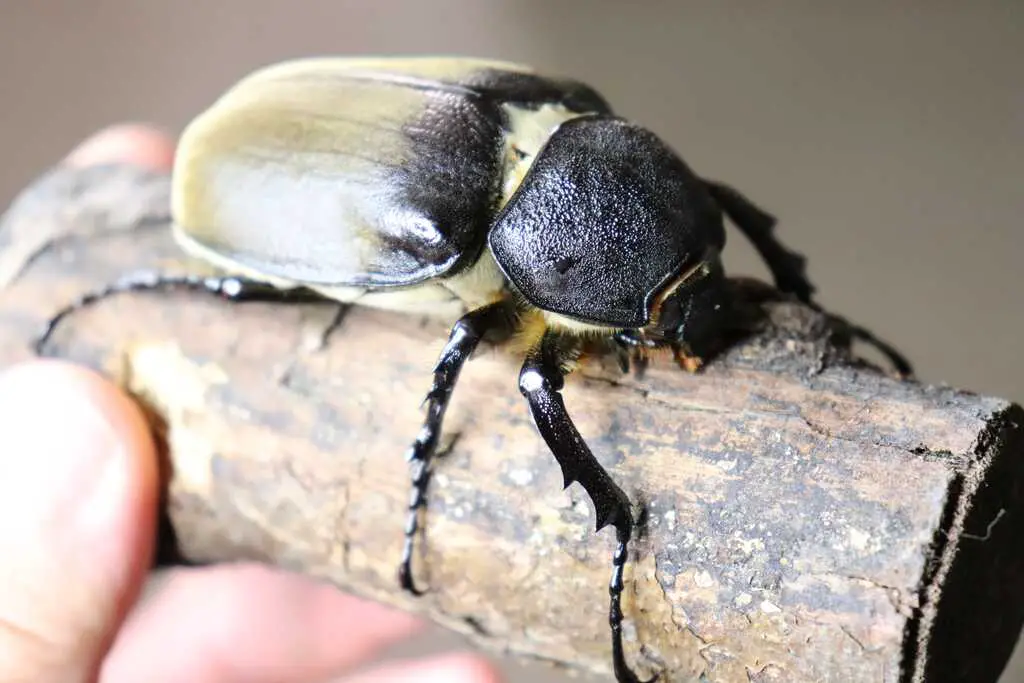
Megasoma pupae typically emerge into adults after 2 months. Don’t be too happy yet, though.
The adult beetle will stay inactive inside the pupation chamber for another 2 weeks to 2 months, depending on species. Larger species take a longer time than smaller species. This is known as the teneral stage, where the exoskeleton of the beetle is yet to fully harden. The teneral beetle does not require any food.
Once the beetle is ready, it breaks and exits the pupation chamber. You should count the dates, and monitor your beetle weekly once it is near to emergence, so that you know it when your beetle finally comes out.
I usually notice the emerging beetle when it starts making sounds from knocking the container wall, attempting to fly.
Adult Megasoma Care
Transfer the adult beetle into a transparent container with adequate ventilation and a secured lid. Megasoma spp are strong fliers. They can easily escape from a container without a secured lid.
As a general rule of thumb, the length of the container should be at least 3 times the length of your beetle, while the width and height should be at least 2 times its length. This allows ample space for the beetle to move around, and prevents it from pushing the lid away.
Adult Megasoma beetles should be housed separated from each other to avoid fighting.
Lay some hay or potting mix in the container as substrates to absorb the excrement of the beetle. Add some decors, such as cork barks and tree branches, in the enclosure. These objects give the beetle a surface to hold onto, and help them recover when they are toppled upside down.
Feed the beetle with fresh, cut fruits or beetle jelly. Replace the food before it rots.
Jelly is more convenient than fresh fruits, as it lasts longer, and it is easier to store. Here is a beetle jelly recipe that you can refer to. If you are using fruits, always place the fruits on a small sauce plate so that you can easily clean the mess.
Keep your adult beetles in the dark, at room temperature. You can use a display light when observing the beetle, but remember to turn it off when finished observing.
When properly taken care of, adult Megasoma can live for 6-8 months. Mated beetles tend to have a much shorter lifespan.
Breeding
Breeding of Megasoma beetles is rather straightforward. It can be rewarding, both psychologically and financially. Yet, it can be frustrating if you don’t do it right, because you may end up with rotten eggs.
Pairing the Male and Female Beetles
Prepare a pair of male and female Megasoma of the same species. Remember, male Megasoma is the one with horns, while female is the one without horns.
Both male and female beetles must have started feeding before they can successfully mate. Preferably, both beetles are aged 1-2 months. The older the beetles, the lesser the eggs they lay, and the least viable are their offspring.
Place the female Megasoma in a container big enough to accommodate 2 beetles. Distract the female by offering her beetle jelly. Ideally, the female should be standing on a solid surface so that the pair does not topple when mating.
Then, introduce the male beetle. The male beetle will go straight to the female, and attempt to mate.
If everything goes right, the female beetle will allow the male to mate. If not, the female will struggle and escape. In such a case, you need to reattempt pairing after a few days.
The whole mating process is about 40 minutes. Do not disturb them while they are mating.
Egg-Laying
Get a 25 L or bigger plastic container. Fill two-thirds of the container with moist flake soil, and compress the flake soil firmly. For this purpose, the flake soil should be slightly moister than the flake soil used to keep the grubs.
Put some cork bark onto the flake soil so that the female beetle has something to grab and recover if she accidentally topples herself.
Place the gravid female Megasoma beetle into the nursery chamber, and offer it beetle jelly. Replace the jelly every 2-3 days to prevent molds.
The female Megasoma beetle will begin to lay eggs around a week after mating, and continues to lay eggs over the course of 1 month. Depending on species, you may get 60-200 eggs. The eggs are white in color, and unmistakable.
Transfer the eggs to another ventilated container containing moist flake soil. The eggs typically hatch in 1 month.
Frequently Asked Questions
Why does my male Megasoma Beetle have a Short Horn?
You probably have a minor male beetle. Minor beetles have a much shorter cephalic horn than the major male. There is no way to tell whether a male beetle is a minor or major morph before it emerges from pupa. It is completely random. Some hobbyists believe that improving the nutrient quality may increase the chance of getting a major beetle.
How to Deal with Mite Infestation?
Remove the grub from the infested enclosure. Using a toothbrush, brush off any mites on the grub. Dispose the infested flake soil, and wash the container thoroughly before reusing it.

